Adaptive Filtering for the Maternal Respiration Signal Attenuation in the Uterine Electromyogram
Abstract
1. Introduction
2. Materials and Methods
2.1. Generation of Synthetic Data
- In real-life signals, for non-invasive acquisition systems, the Alv waves are substantially contaminated with MR-EMG interference. Therefore, it is not possible, in this case, to have the pure Alv waves, unless invasive electrodes are placed directly on the uterine muscle. However, this procedure may raise ethical concerns in most situations and, therefore, it is not practical.
- The aforementioned fact prevents an accurate filter and parameters optimization, regarding MR-EMG attenuation.
- Hence, the need to use analytically defined signals for the MR-EMG and Alv waves, which can only be achieved using synthetic data.
- These synthetic signals should be generated using features and properties as close as possible to the corresponding real data.
- Smooth (chirp) breathing variation: a linear variation between temporal and frequency limits, from slow to fast breathing. The study for this case will be designated as the first simulation.
- Breathing variation in a triangular wave shape from smooth to fast in 250 seconds for eight cycles. The study for this case will be referred to as the second simulation.
- Random variation of the breathing regime in the previously mentioned band. The study for this case will be referred to as the third simulation.
2.2. Adaptive Filters and Parameters Optimization and Selection
- For each filter, if one of the parameters is equally valued in the three simulated cases, it will be selected.
- For each filter, one of the parameters is different for at least two simulation cases. In this case, the parameter corresponding to the second simulation is selected. This corresponds to the worst-case scenario, since this simulated signal contains abrupt changes that are challenging for the adaptive filters.
2.3. Application of the Selected Filters to Real Data
- Bandwidth (bw) defined as the frequency band that contains 75% of the energy of each Alv wave, Hz.
- Bandwidth low frequency bound (flo), Hz.
- Bandwidth high frequency bound (fhi), Hz.
- Signal power in the occupied bandwidth (power), Watt.
- Amplitude peak (peak), V.
- The frequency corresponding to the amplitude peak (freq_peak), Hz.


Statistical Validation Method
- represents the mean value of the raw signal,
- is the mean value of the outputs of the Wiener filter,
- is the mean value of the output of RLS/HRLS/QRD-RLS filters, for the i-th feature (i = 1, …, 6).
3. Results
3.1. Application to Synthetic Data
- The lowest RMSE for the three simulation signals corresponded to the Wiener filter. This filter implementation may be challenging for certain real-time applications. Hence, the need to score other filters.
- In the first and third simulations, the lowest RMSE values corresponded to the RLS; HRLS and QRD-RLS tied.
- Since the lowest RMSE value of the second simulation corresponded to the SELMS and, using a majority criterion, the winners after the Wiener filter were: RLS, HRLS, and QRD-RLS alike.
3.2. Application to Real Data
- A substantial power decrease (∆power) was observed for the Wiener filter (p = 1.31 × 10−12). For the other filters (p = 3.82 × 10−5), the power decrease was roughly halved in the median and quartiles, relative to the Wiener filter. This may reflect the Wiener filter outperforming the attenuation of respiratory signal, as has been verified in the simulation data. This also highlights that the in-phase subtraction between the noise estimation and Alv waves was prevalent, relative to the counter-phase one.
- The bandwidth increase (∆bw) for all filters (p = 1.20 ×10−45 for Wiener and p = 1.66 × 10−12 for other filters) was a direct consequence of the reduction of the power (∆power). To allow for the 75% energy ratio, the bandwidth must increase.
- To allow for the bandwidth increase, the frequency limits ∆flo (p = 0.00 for Wiener and p = 4.44 × 10−16 for other filters) and ∆fhi (p = 2.46 × 10−28 for Wiener and p = 6.39 × 10−9 for other filters) decreased and increased, respectively.
- A substantial decrease in the periodograms peak (∆peak) was observed, which is consistent with the above-reported decrease in the power (∆power) for the Wiener filter (p = 4.11 × 10−13). For the other filters, the ∆peak decrease (p = 1.46 × 10−5) was roughly halved in the median and quartiles, relative to the Wiener filter.
- Since the ∆flo decrease was higher than the ∆fhi increase, the peak frequency deviation (∆freq_peak) was negative or negligible in all cases (p = 1.19 × 10−8 for Wiener and p = 3.59 × 10−4 for other filters). This indicates that the attenuation of the respiratory signal led to a lower frequency peak.
4. Discussion and Conclusions
- Maternal respiratory signal (MR-EMG) attenuation in the EHG, which is a problem often overlooked or dealt with, in many cases, using bipolar channels.
- Algorithm development to find the optimal adaptive filters and their parameters for the MR-EMG attenuation in the EHG.
- A contribution to adaptive filtering behavior insight, which is important for the interpretation of the results. This information could be relevant for other researchers in the biomedical signal processing field.
Author Contributions
Funding
Institutional Review Board Statement
Informed Consent Statement
Data Availability Statement
Conflicts of Interest
References
- Dbstet, A. Modifications recommended by FIGO as amended October 14, 1976. Acta Obstet. Gynecol. Scand. 1977, 56, 247–253. [Google Scholar]
- World Health Organization; March of Dimes; The Partnership for Maternal. Born Too Soon: The Global Action Report on Preterm Birth. 2012. Available online: https://www.who.int/pmnch/media/news/2012/201204_borntoosoon-report.pdf (accessed on 28 August 2022).
- Koullali, B.; Oudijk, M.A.; Nijman, T.A.J.; Mol, B.W.J.; Pajkrt, E. Risk assessment and management to prevent preterm birth. Semin. Fetal Neonatal Med. 2016, 21, 80–88. [Google Scholar] [CrossRef] [PubMed]
- Son, M.; Miller, E.S. Predicting preterm birth: Cervical length and fetal fibronectin. Semin. Perinatol. 2017, 41, 445–451. [Google Scholar] [CrossRef] [PubMed]
- Suff, N.; Story, L.; Shennan, A. The prediction of preterm delivery: What is new? Semin. Fetal Neonatal Med. 2019, 24, 27–32. [Google Scholar] [CrossRef] [PubMed]
- Garcia-Casado, J.; Ye-Lin, Y.; Prats-Boluda, G.; Mas-Cabo, J.; Alberola-Rubio, J.; Perales, A. Electrohysterography in the diagnosis of preterm birth: A review. Physiol. Meas. 2018, 39, 23. [Google Scholar] [CrossRef] [PubMed]
- Nieto-del-Amor, F.; Beskhani, R.; Ye-Lin, Y.; Garcia-Casado, J.; Diaz-Martinez, A.; Monfort-Ortiz, R.; Diago-Almela, V.J.; Hao, D.; Prats-Boluda, G. Assessment of Dispersion and Bubble Entropy Measures for Enhancing Preterm Birth Prediction Based on Electrohysterographic Signals. Sensors 2021, 21, 6071. [Google Scholar] [CrossRef] [PubMed]
- Batista, A.G.; Cebola, R.; Esgalhado, F.; Russo, S.; Reis, C.R.P.d.; Serrano, F.; Vassilenko, V.; Ortigueira, M. The contractiongram: A method for the visualization of uterine contraction evolution using the electrohysterogram. Biomed. Signal Process. Control 2021, 67, 102531. [Google Scholar] [CrossRef]
- Esgalhado, F.; Batista, A.G.; Mouriño, H.; Russo, S.; Reis, C.R.P.d.; Serrano, F.; Vassilenko, V.; Ortigueira, M.D. Automatic Contraction Detection Using Uterine Electromyography. Appl. Sci. 2020, 10, 7014. [Google Scholar] [CrossRef]
- Karlsson, B.; Terrien, J.; Gudmundsson, V.; Steingrimsdottir, T.; Marque, C. Abdominal EHG on a 4 by 4 grid: Mapping and presenting the propagation of uterine contractions. IFMBE Proc. 2007, 16, 139–143. [Google Scholar] [CrossRef]
- Batista, A.G.; Najdi, S.; Godinho, D.M.; Martins, C.; Serrano, F.C.; Ortigueira, M.D.; Rato, R.T. A multichannel time–frequency and multi-wavelet toolbox for uterine electromyography processing and visualisation. Comput. Biol. Med. 2016, 76, 178–191. [Google Scholar] [CrossRef] [PubMed]
- Seeley, R.R.; Stephens, T.D.; Tate, P. Anatomy & Physiology, 6th ed.; McGraw-Hill Science/Engineering/Math: New York, NY, USA, 2003. [Google Scholar]
- McConnell, A. Respiratory Muscle Training: Theory and Practice, 1st ed.; Churchill Livingstone: Edinburgh, UK, 2013. [Google Scholar]
- Breslin, E.H. The pattern of respiratory muscle recruitment during pursed-lip breathing. Chest 1992, 101, 75–78. [Google Scholar] [CrossRef] [PubMed]
- Bedeeuzzaman, A.S.M. Preterm Birth Prediction Using EHG Signals. Int. J. Sci. Res. Eng. Trends 2019, 5, 2395–2566. [Google Scholar]
- Fele-Žorž, G.; Kavšek, G.; Novak-Antolič, Ž.; Jager, F. A comparison of various linear and non-linear signal processing techniques to separate uterine EMG records of term and pre-term delivery groups. Med. Biol. Eng. Comput. 2008, 46, 911–922. [Google Scholar] [CrossRef] [PubMed]
- Esgalhado, F.; Batista, A.G.; Mouriño, H.; Russo, S.; Reis, C.R.P.d.; Serrano, F.; Vassilenko, V.; Ortigueira, M. Uterine contractions clustering based on electrohysterography. Comput. Biol. Med. 2020, 123, 103897. [Google Scholar] [CrossRef]
- Carré, P.; Leman, H.; Fernandez, C.; Marque, C. Denoising of the uterine EHG by an undecimated wavelet transform. IEEE Trans. Biomed. Eng. 1998, 45, 1104–1113. [Google Scholar] [CrossRef]
- Terrien, J.; Marque, C.; Steingrimsdottir, T.; Karlsson, B. Evaluation of adaptive filtering methods on a 16 electrode electrohysterogram recorded externally in labor. In Proceedings of the 11th Mediterranean Conference on Medical and Biomedical Engineering and Computing, Ljubljana, Slovenia, 26–30 June 2007; pp. 135–138. [Google Scholar] [CrossRef]
- Limem, M.; Hamdi, M.A.; Maaref, M.A. Denoising uterine EMG signals using LMS and RLS adaptive algorithms. In Proceedings of the 2nd International Conference on Advanced Technologies for Signal and Image Processing (ATSIP), Monastir, Tunisia, 21–23 March 2016; pp. 273–276. [Google Scholar] [CrossRef]
- Bode, O. Das Elektrohysterogramm. Arch. Gynakol. 1931, 146, 123–128. [Google Scholar] [CrossRef]
- Marque, C.; Duchene, J.M.G.; Leclercq, S.; Panczer, G.S.; Chaumont, J. Uterine EHG Processing for Obstetrical Monitorng. IEEE Trans. Biomed. Eng. BME 1986, 33, 1182–1187. [Google Scholar] [CrossRef]
- Devedeux, D.; Marque, C.; Mansour, S.; Germain, G.; Duchêne, J. Uterine electromyography: A critical review. Am. J. Obstet. Gynecol. 1993, 169, 1636–1653. [Google Scholar] [CrossRef]
- Sims, S.M.; Daniel, E.E.; Garfield, R.E. Improved electrical coupling in uterine smooth muscle is associated with increased numbers of gap junctions at parturition. J. Gen. Physiol. 1982, 80, 353–375. [Google Scholar] [CrossRef]
- Léman, H.; Marque, C.; Gondry, J. Use of the electrohysterogram signal for characterization of contractions during pregnancy. IEEE Trans. Biomed. Eng. 1999, 46, 1222–1229. [Google Scholar] [CrossRef]
- Marque, C.; Diab, A.; Laforêt, J.; Hassan, M.; Karlsson, B. Dynamic Behavior of Uterine Contractions: An Approach Based on Source Localization and Multiscale Modeling. Knowl. Syst. Eng. 2015, 326, 527–540. [Google Scholar] [CrossRef]
- Garfield, R.E.; Lucovnik, M.; Chambliss, L.; Qian, X. Monitoring the onset and progress of labor with electromyography in pregnant women. Curr. Opin. Physiol. 2020, 13, 94–101. [Google Scholar] [CrossRef]
- Alvarez, H.; Caldeyro, R. Contractility of the human uterus recorded by new methods. Surg. Gynecol. Obstet. 1950, 91, 15442821. [Google Scholar]
- Russo, S.; Batista, A.; Esgalhado, F.; Reis, C.R.P.d.; Serrano, F.; Vassilenko, V.; Ortigueira, M. Alvarez waves in pregnancy: A comprehensive review. Biophys. Rev. 2021, 13, 563–574. [Google Scholar] [CrossRef]
- Roberts, W.F.; Perry, K.G.; Naef, R.W.; Washburne, J.F.; Morrison, J.C. The irritable uterus: A risk factor for preterm birth? Am. J. Obstet. Gynecol. 1995, 172, 138–142. [Google Scholar] [CrossRef]
- Martin, J.N.; McColgin, S.W.; Martin, R.W.; Roach, H.; Morrison, J.C. Uterine activity among a diverse group of patients at high risk for preterm delivery. Obstet. Gynecol. 1990, 76, 47S–51S. [Google Scholar] [CrossRef]
- Smyth, C. Uterine irritability. the concept and its clinical applications, exemplified by the oxytocin-sensitivity test. Obstet. Gynecol. Surv. 1958, 13, 322–324. [Google Scholar] [CrossRef]
- Newman, R.B.; Gill, P.J.; Campion, S.; Katz, M. The influence of fetal number on antepartum uterine activity. Obstet. Gynecol. 1989, 73 Pt 1, 695–699. [Google Scholar]
- Warkentin, B. Uterine activity under tocolysis through a beta-sympathomimetic (author’s transl). Z. Geburtshilfe Perinatol. 1976, 180, 230–233. [Google Scholar] [PubMed]
- Newman, R.B.; Gill, P.J.; Campion, S.; Katz, M. Antepartum ambulatory tocodynamometry: The significance of low-amplitude, high-frequency contractions. Obstet. Gynecol. 1987, 70, 701–705. [Google Scholar]
- Liu, S.; Liu, D.; Zhang, J.; Zeng, Y. Extraction of fetal electrocardiogram using recursive least squares and normalized least mean squares algorithms. In Proceedings of the 3rd International Conference on Advanced Computer Control, Harbin, China, 18–20 January 2011; pp. 333–336. [Google Scholar] [CrossRef]
- Khalaf, J.; Moslem, B.; Bazzi, O.; Diab, M.O. Fetal ECG extraction from abdominal composite recordings—A preliminary study. In Proceedings of the 2nd International Conference on Advances in Biomedical Engineering, Tripoli, Lebanon, 11–13 September 2013; pp. 133–136. [Google Scholar] [CrossRef]
- Kahankova, R.; Martinek, R.; Bilik, P. Fetal ECG extraction from abdominal ECG using RLS based adaptive algorithms. In Proceedings of the 18th International Carpathian Control Conference, ICCC, Sinaia, Romania, 28–31 May 2017; pp. 337–342. [Google Scholar] [CrossRef]
- Hamdi, M.A.; Limem, M.; Maaref, M.A. Detection and Classification of Nonstationary Signals: Application to Uterine EMG for Prognostication of Premature Delivery. Neurophysiology 2019, 51, 272–280. [Google Scholar] [CrossRef]
- Smrdel, A.; Jager, F. Separating sets of term and pre-term uterine EMG records. Physiol. Meas. 2015, 36, 341–355. [Google Scholar] [CrossRef]
- Tong, H.; Zhao, Z.; Deng, Y. A comprehensive adaptive filtering algorithm for uterine contraction pressure signals. In Proceedings of the 10th International Congress on Image and Signal Processing, BioMedical Engineering and Informatics (CISP-BMEI), Chengdu, China, 17–19 October 2018; pp. 1–7. [Google Scholar] [CrossRef]
- Anuradha, P.; Arabelli, R.; Rajkumar, K. Noise removal of ECG signals with adaptive filtering. Mater. Today Proc. 2021, 1–6. [Google Scholar] [CrossRef]
- Sehamby, R.; Singh, B. Noise cancellation using adaptive filtering in ECG signals: Application to biotelemetry. Int. J. Bio-Sci. Bio-Technol. 2016, 8, 237–244. [Google Scholar] [CrossRef]
- Lu, G.; Brittain, J.-S.; Holland, P.; Yianni, J.; Green, A.L.; Stein, J.F.; Aziz, T.Z.; Wang, S. Removing ECG noise from surface EMG signals using adaptive filtering. Neurosci. Lett. 2009, 462, 14–19. [Google Scholar] [CrossRef]
- He, P.; Wilson, G.; Russell, C. Removal of ocular artifacts from electro-encephalogram by adaptive filtering. Med. Biol. Eng. Comput. 2004, 42, 407–412. [Google Scholar] [CrossRef]
- Komorowski, D.; Tkacz, E. A new method for attenuation of respiration artifacts in electrogastrographic (EGG) signals. In Proceedings of the 37th Annual International Conference of the IEEE Engineering in Medicine and Biology Society (EMBC), Milan, Italy, 25–29 August 2015; pp. 6006–6009. [Google Scholar] [CrossRef]
- Haykin, S.S. Adaptive Filter Theory, 3rd ed.; Prentice Hall: Hoboken, NJ, USA, 1996. [Google Scholar]
- Alexandersson, A.; Steingrimsdottir, T.; Terrien, J.; Marque, C.; Karlsson, B. The Icelandic 16-electrode electrohysterogram database. Sci. Data 2015, 2, 150017. [Google Scholar] [CrossRef]
- Moody, G.B.; Mark, R.G.; Zocola, A.; Mantero, S. Derivation of Respiratory Signals From Multi-Lead Ecgs. Comput. Cardiol. 1985, 12, 113–116. [Google Scholar]
- de Sousa, C.M.M.F.C. Electrohysterogram Signal Component Cataloging with Spectral and Time-Frequency Methods. Ph.D. Thesis, NOVA School of Science and Technology, Caparica, Portugal, 2015. [Google Scholar]
- Daniel, W.W. Biostatistics: A Foundation for Analysis in the Health Science, 10th ed.; Wiley: Hoboken, NJ, USA, 2013. [Google Scholar]
- Wright, S.P. Adjusted P-Values for Simultaneous Inference. Biometrics 1992, 48, 1005. [Google Scholar] [CrossRef]
- Chen, S.-Y.; Feng, Z.; Yi, X. A general introduction to adjustment for multiple comparisons. J. Thorac. Dis. 2017, 9, 1725–1729. [Google Scholar] [CrossRef] [PubMed]


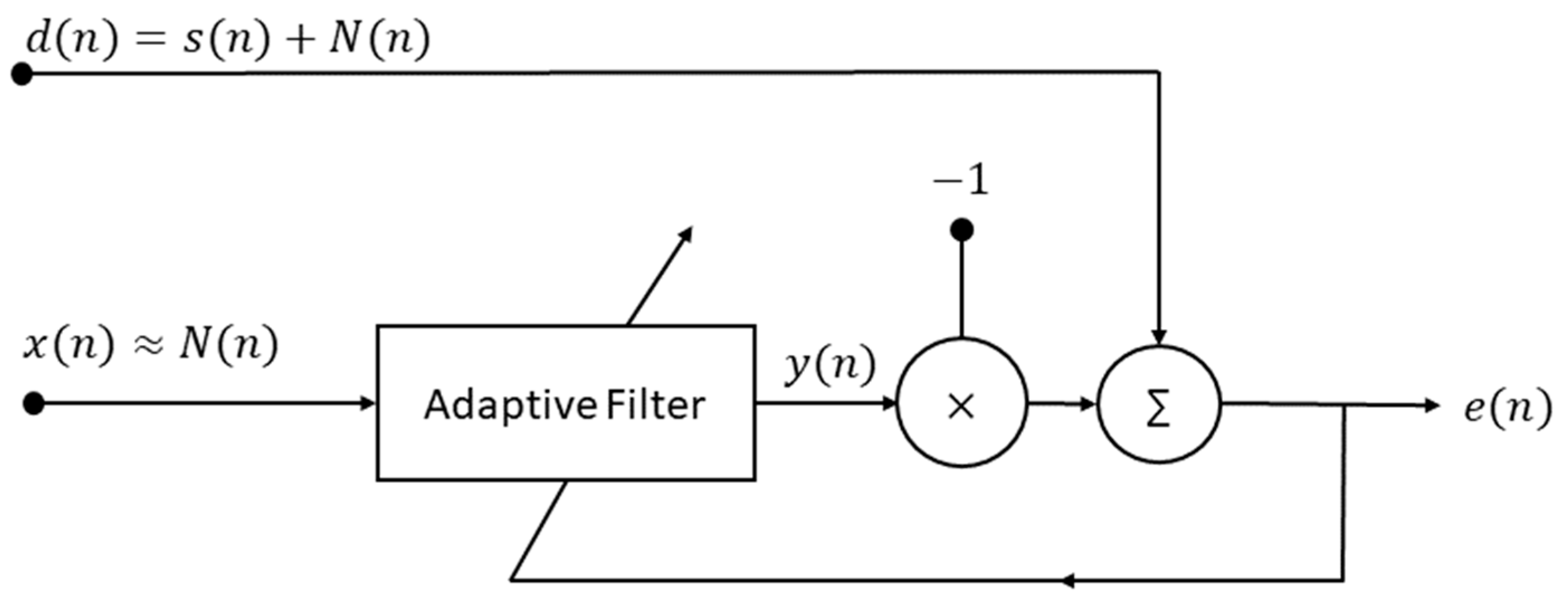

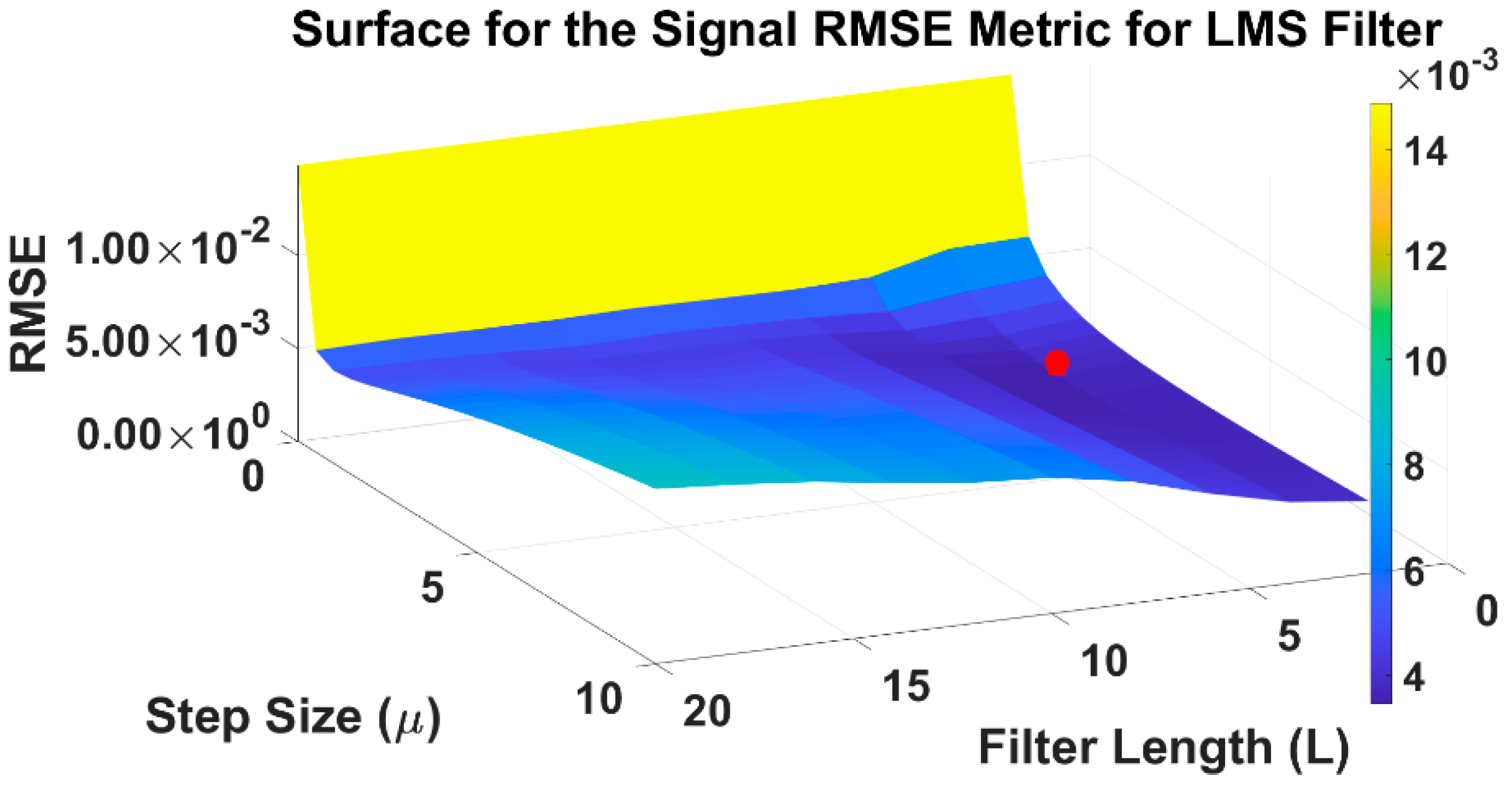
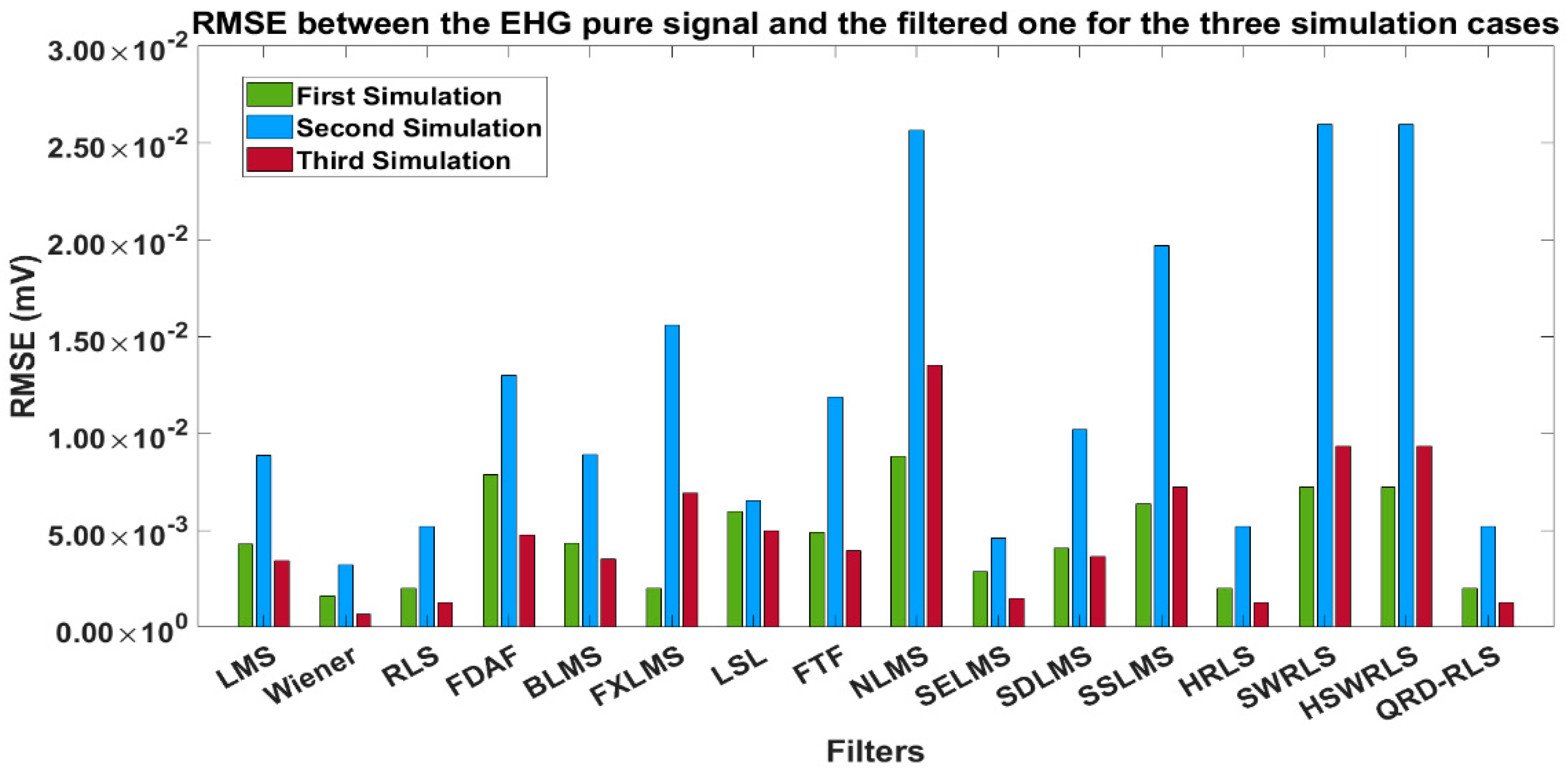
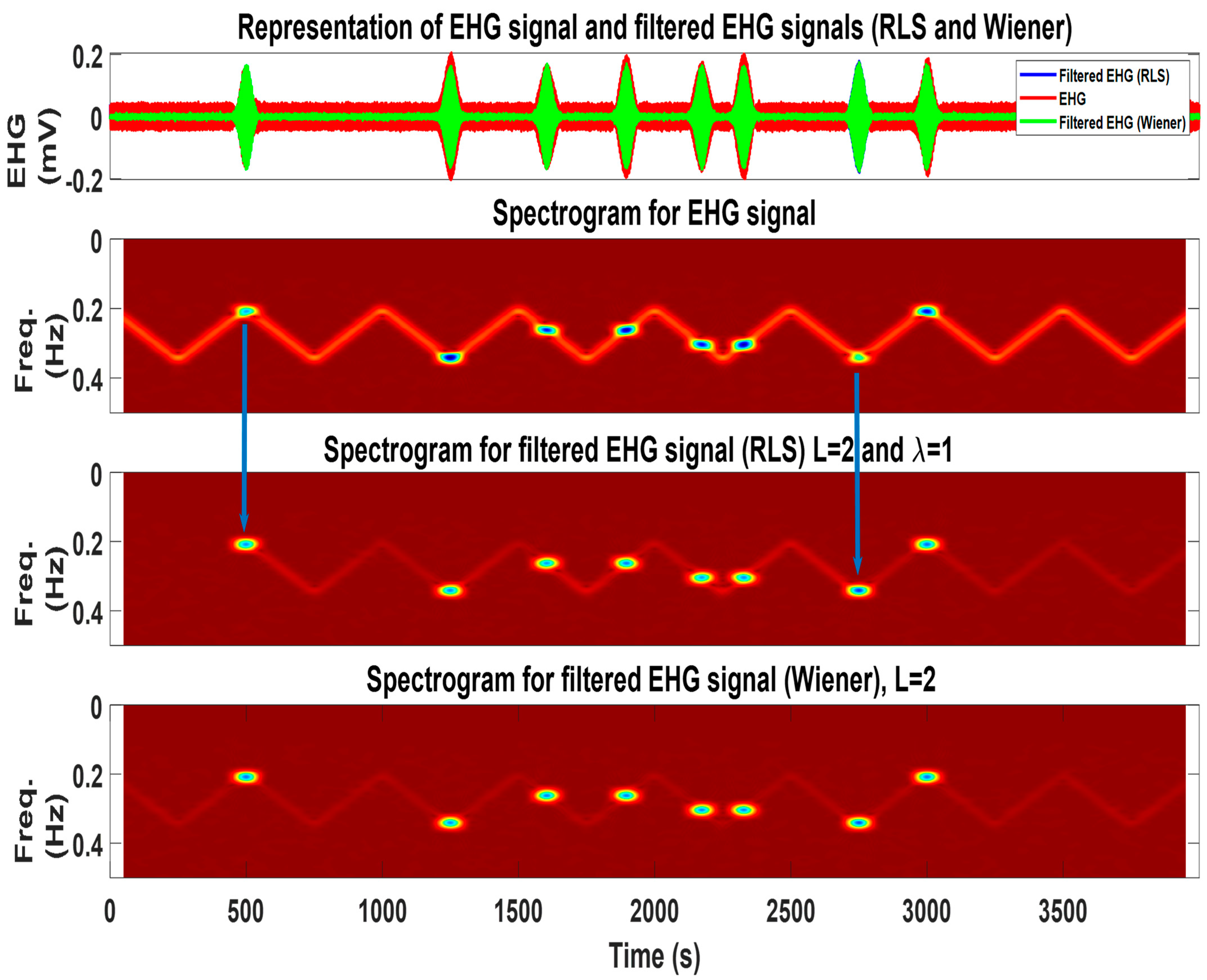

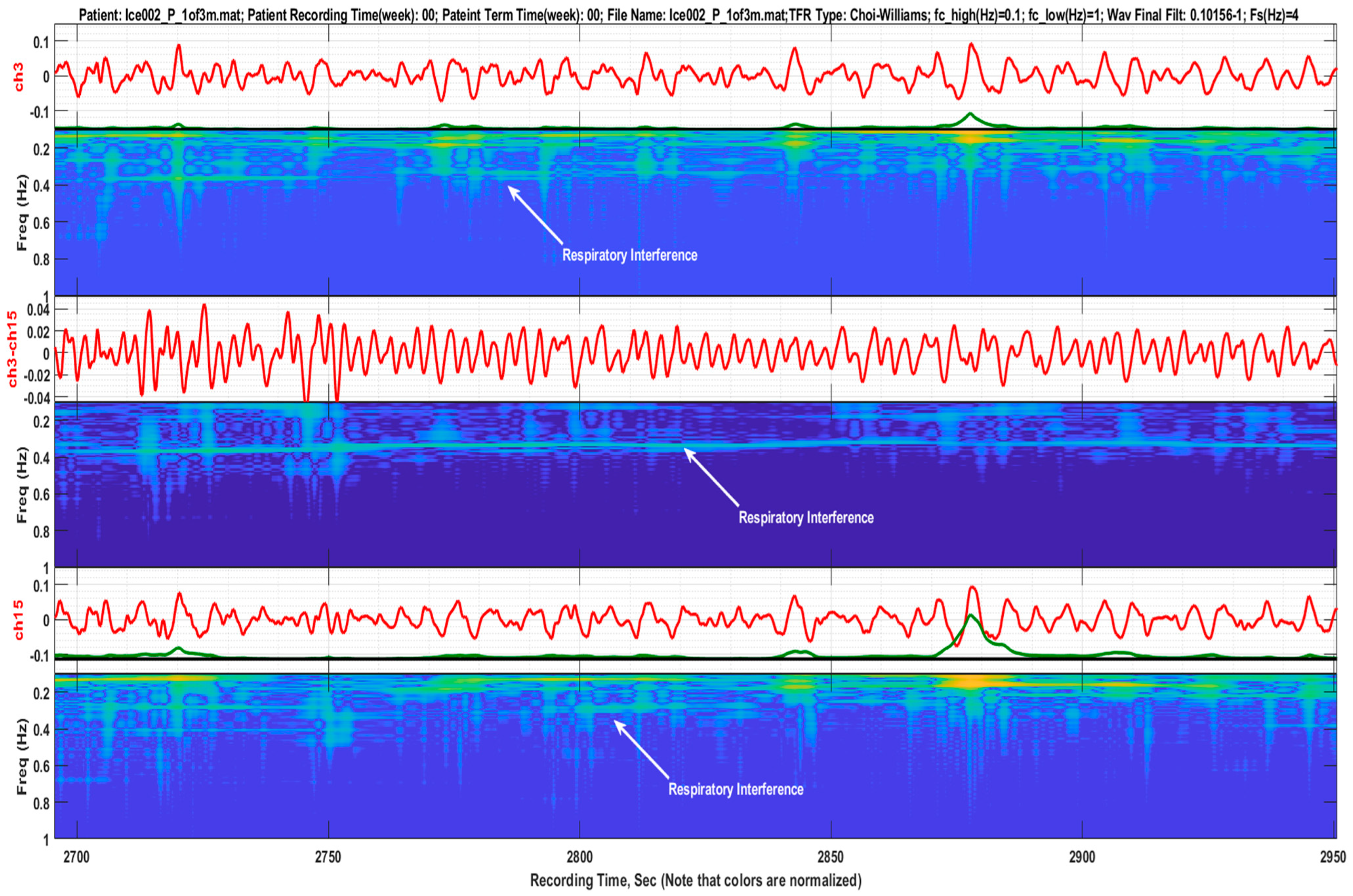
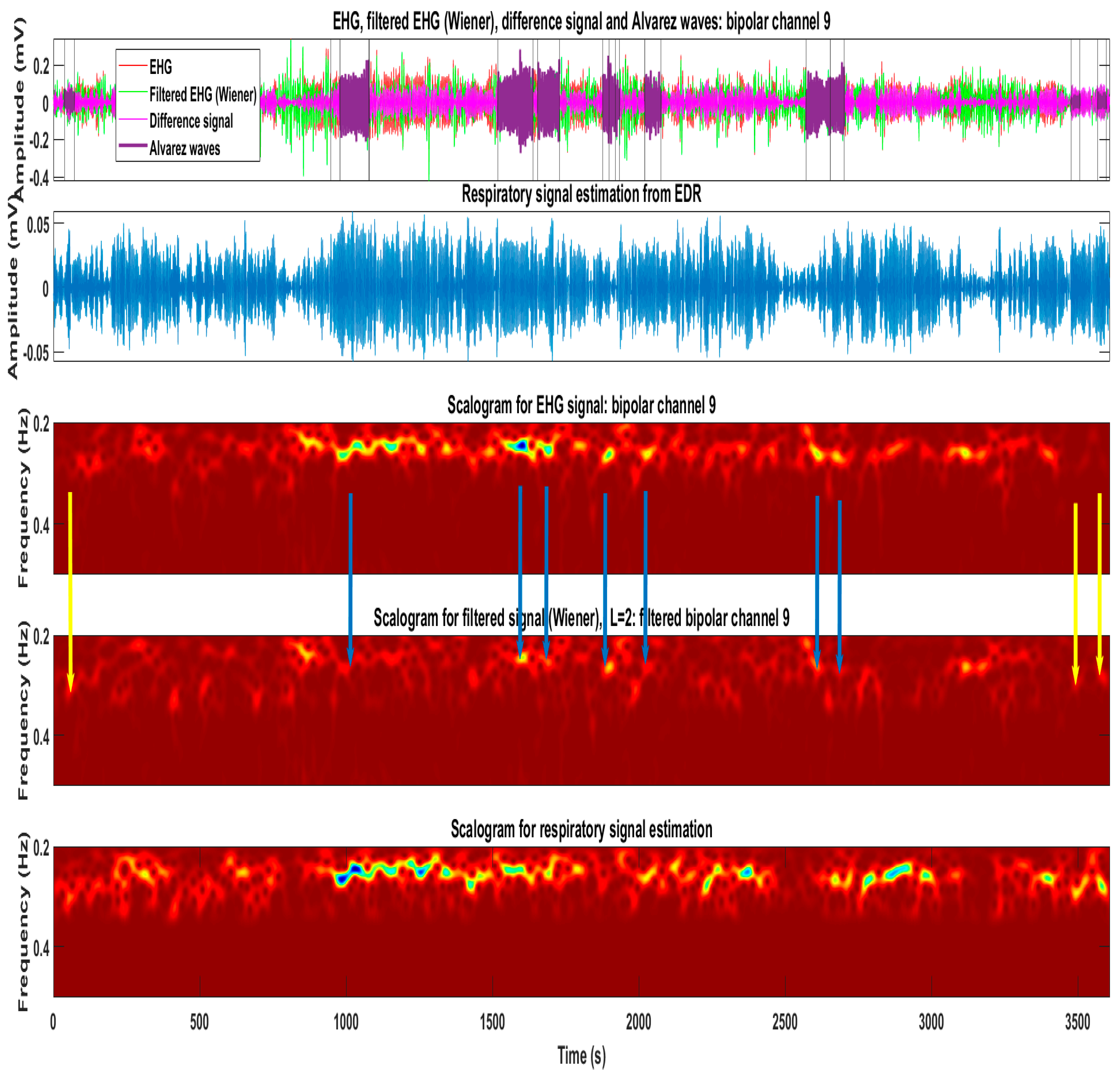
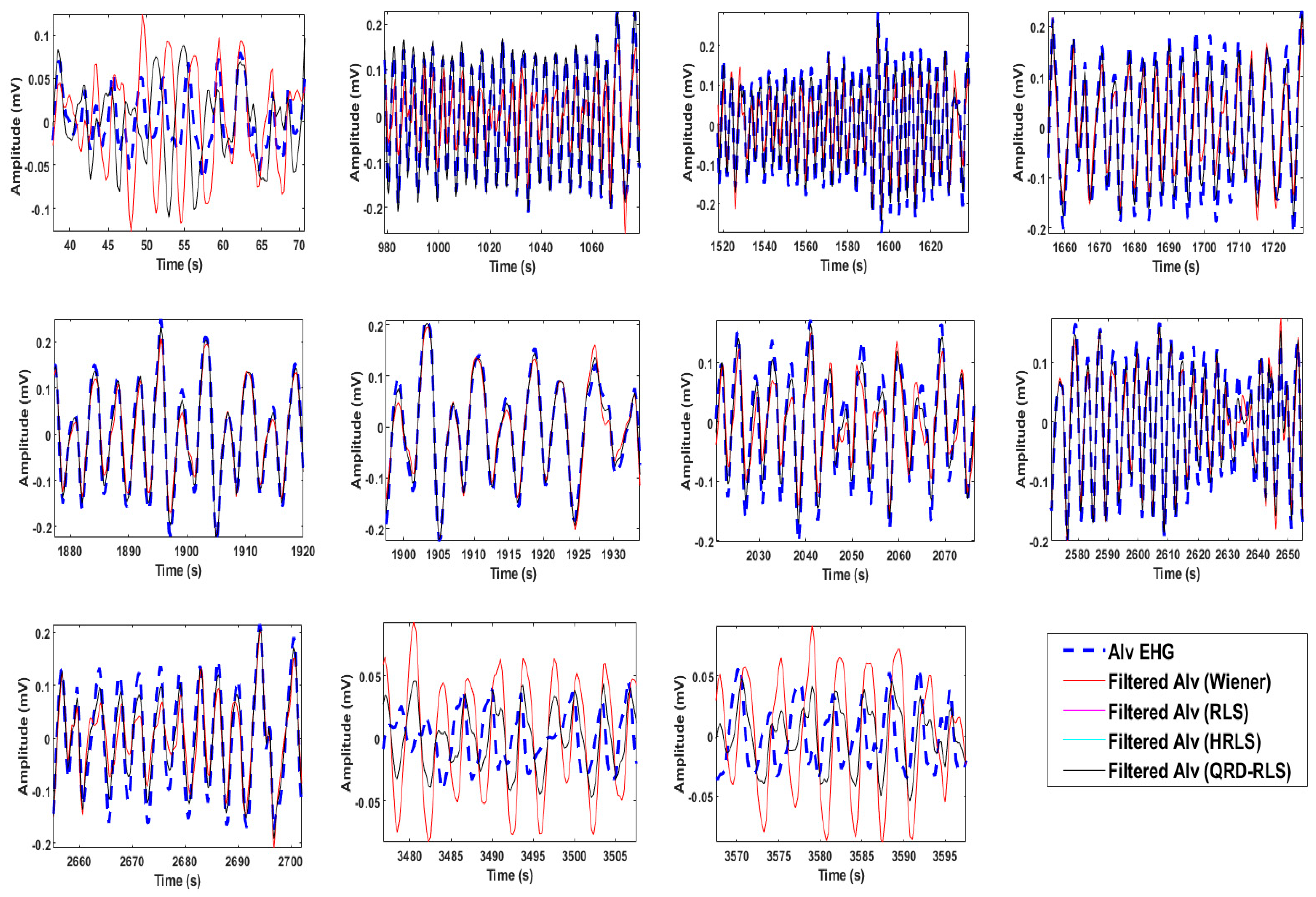



| Authors and Year | Purpose of the Work | Reference Signal | Filters | Parameters and Data | Results and Observations |
|---|---|---|---|---|---|
| Jérémy Terrien et al., 2007 [19] | Exploring the performance of RLS and LMS adaptive filters as a preprocessing technique for monopolar EHG signals. The used metric was the signal-to-noise ratio. | Average of the four vertical EHG monopolar channels | RLS and LMS (adaptive) and Laplacian (non-adaptive) |
fs = 200 Hz; ε = 0.001; λ = 1; μ = 0.1; L = (4,8,12,16,20,24,28,32,36,40,48,56). Measurements were performed by a 16-channel physiological signal recorder. The sample was from two women in spontaneous labour (37 and 39 weeks). |
|
|
Shi-jin Liu et al., 2011 [36] | Maternal ECG signal attenuation, followed by fECG extraction using adaptive filtering algorithms (RLS and NLMS). | Maternal ECG | RLS and NLMS (adaptive) |
fs = 500 Hz; λ = 0.98; μ = 0.16; L = 4; σ = 0.001. The used data corresponds to real signals. They were recorded by placing skin electrodes on the abdominal region. Each signal contains 4000 sampling points. |
|
| Jamila Khalaf et al., 2013 [37] | Directly retrieves the fECG from the composite signals, without using the maternal ECG reference signal. | ICA estimation of the maternal ECG | LMS (adaptive) and bandpass filter between 1 and 150 Hz (non-adaptive) |
fs = 1 kHz. Parameters’ information was undisclosed. Clinical data pool: abdominal surface recordings from five women between 38 to 41 weeks of gestation, collected during labour. Each data set comprises six different signals: four composite signals through four electrodes. A direct fECG recorded from the fetal scalp was used for correlation analysis. |
|
| Ales Smrdel et al., 2015 [40] | Prediction and classification of EHG term and pre-term recordings. | Undisclosed | RLS (adaptive) |
fs = 20 Hz; λ = 0.9995; L = 12. Several parameters were tested, and the best performer was presented. Data pool: term–preterm EHG (TP-EHG) database (300 recordings). |
|
| Manel Limem et al., 2016 [20] |
Attenuation of the electronic electromagnetic and ECG maternal interferences present in the EHG, using the adaptive filter algorithms. Comparing the results of the adaptive filtering methods with the wavelet transform and bandpass filter. | The uterine electromyography signal was combined with random noise | LMS and RLS (adaptive) and bandpass filter between 0.34 and 1 Hz and discrete wavelet transform: db4 (non-adaptive) |
Filter parameters undisclosed. Four EHG signals from the TP-EHG database were used. |
|
| Kahankova et al., 2017 [38] | Extracting the fECG from the EHG signal using some finite impulse response (FIR) adaptive filters, based on the RLS algorithm. Evaluation of the filter’s performance. | Maternal ECG | RLS and FTF (adaptive) |
RLS (λ = 1; L = 30); FTF (L = 15; δ = 0.01). These parameters were optimized for the used synthetic data. |
|
| Simulation Type | Bandwidth (Hz) | Central Frequency (Hz) | Central Time (s) |
|---|---|---|---|
| First simulation | 0.02 | 0.2500 | 1000 |
| 0.3500 | 3000 | ||
| Second simulation | 0.02 | 0.2084 | 500 |
| 0.3415 | 1250 | ||
| 0.2622 | 1604 | ||
| 0.2622 | 1896 | ||
| 0.3043 | 2173 | ||
| 0.3043 | 2327 | ||
| 0.3415 | 2750 | ||
| 0.2084 | 3000 | ||
| Third simulation | 0.02 | 0.2500 | 1000 |
| 0.3000 | 2000 | ||
| 0.3500 | 3000 |
| L | μ | λ | |||||||
|---|---|---|---|---|---|---|---|---|---|
| Filter | Min | Max | Step | Min | Max | Step | Min | Max | Step |
| LMS | 2 | 20 | 2 | 0.0 | 10.0 | 0.5 | - | - | - |
| NLMS | 2 | 20 | 2 | 0.0+ | 2.0 | 0.5 | - | - | - |
| FDAF | 2 | 20 | 2 | 0.0+ | 1.0 | 0.2 | - | - | - |
| BLMS | 2 | 20 | 2 | 0.0 | 10.0 | 0.5 | - | - | - |
| FXLMS | 2 | 20 | 2 | 0.0 | 10.0 | 0.5 | - | - | - |
| SELMS | 2 | 20 | 2 | 0.0 | 10.0 | 0.5 | - | - | - |
| SDLMS | 2 | 20 | 2 | 0.0 | 3.0 | 0.5 | - | - | - |
| SSLMS | 2 | 20 | 2 | 0.0 | 5.0 | 0.5 | - | - | - |
| LSL | 5 | 100 | 5 | - | - | - | 0.10 | 1.00 | 0.10 |
| RLS | 2 | 20 | 2 | - | - | - | 0.95 | 1.00 | 0.01 |
| HRLS | 2 | 20 | 2 | - | - | - | 0.40 | 1.00 | 0.10 |
| SWRLS | 2 | 20 | 2 | - | - | - | 0.95 | 1.00 | 0.01 |
| HSWRLS | 2 | 20 | 2 | - | - | - | 0.20 | 1.00 | 0.10 |
| QRD-RLS | 2 | 20 | 2 | - | - | - | 0.10 | 1.00 | 0.10 |
| Filter | Sim. Type | L | μ | λ | Filter | Sim. Type | L | μ | λ |
|---|---|---|---|---|---|---|---|---|---|
| LMS | 1st Sim. | 2 | 4.80 | - | FTF | 1st Sim. | 2 | - | 0.99 |
| 2nd Sim. | 2 | 0.70 | 2nd Sim. | 11 | 1.00 | ||||
| 3rd Sim. | 4 | 3.70 | 3rd Sim. | 2 | 0.98 | ||||
| NLMS | 1st Sim. | 11 | 0.05 | - | LSL | 1st Sim. | 6 | - | 1.00 |
| 2nd Sim. | 2 | 0.05 | 2nd Sim. | 3 | 1.00 | ||||
| 3rd Sim. | 4 | 0.05 | 3rd Sim. | 33 | 1.00 | ||||
| FDAF | 1st Sim. | 16 | 0.10 | - | RLS | 1st Sim. | 2 | - | 1.00 |
| 2nd Sim. | 10 | 0.10 | 2nd Sim. | 2 | 1.00 | ||||
| 3rd Sim. | 13 | 0.10 | 3rd Sim. | 2 | 1.00 | ||||
| BLMS | 1st Sim. | 2 | 4.60 | - | HRLS | 1st Sim. | 2 | - | 1.00 |
| 2nd Sim. | 2 | 0.70 | 2nd Sim. | 2 | 1.00 | ||||
| 3rd Sim. | 4 | 3.50 | 3rd Sim. | 2 | 1.00 | ||||
| FXLMS | 1st Sim. | 7 | 1.70 | - | SWRLS | 1st Sim. | 2 | - | 1.00 |
| 2nd Sim. | 6 | 0.20 | 2nd Sim. | 2 | 1.00 | ||||
| 3rd Sim. | 10 | 2.50 | 3rd Sim. | 2 | 1.00 | ||||
| SELMS | 1st Sim. | 2 | 0.15 | - | HSWRLS | 1st Sim. | 2 | - | 1.00 |
| 2nd Sim. | 2 | 0.05 | 2nd Sim. | 2 | 1.00 | ||||
| 3rd Sim. | 2 | 0.20 | 3rd Sim. | 2 | 1.00 | ||||
| SDLMS | 1st Sim. | 2 | 0.10 | - | QRD-RLS | 1st Sim. | 2 | - | 1.00 |
| 2nd Sim. | 2 | 0.05 | 2nd Sim. | 2 | 1.00 | ||||
| 3rd Sim. | 4 | 0.05 | 3rd Sim. | 2 | 1.00 | ||||
| SSLMS | 1st Sim. | 2 | 0.05 | - | Wiener | 1st Sim. | 2 | - | - |
| 2nd Sim. | 2 | 0.05 | 2nd Sim. | 2 | |||||
| 3rd Sim. | 2 | 0.05 | 3rd Sim. | 2 |
| Filters | First Simulation Signals | Second Simulation Signals | Third Simulation Signals |
|---|---|---|---|
| LMS | 4. 29 × 10−3 | 8. 85 × 10−3 | 3. 44 × 10−3 |
| NLMS | 8. 80 × 10−3 | 2. 56 × 10−2 | 1. 35 × 10−2 |
| FDAF | 7. 85 × 10−3 | 1. 30 × 10−2 | 4. 78 × 10−3 |
| BLMS | 4. 34 × 10−3 | 8. 90 × 10−3 | 3. 52 × 10−3 |
| FXLMS | 5. 21 × 10−3 | 1. 56 × 10−2 | 6. 92 × 10−3 |
| SELMS | 2. 81 × 10−3 | 4. 60 × 10−3 | 1. 49 × 10−3 |
| SDLMS | 4. 09 × 10−3 | 1. 02 × 10−2 | 3. 66 × 10−3 |
| SSLMS | 6. 35 × 10−3 | 1. 97 × 10−2 | 7. 24 × 10−3 |
| FTF | 4. 89 × 10−3 | 1. 19 × 10−2 | 3. 95 × 10−3 |
| LSL | 5. 96 × 10−3 | 6. 55 × 10−3 | 5. 00 × 10−3 |
| RLS | 2. 01 × 10−3 | 5. 18 × 10−3 | 1. 25 × 10−3 |
| HRLS | 2. 01 × 10−3 | 5. 18 × 10−3 | 1. 25 × 10−3 |
| SWRLS | 7. 21 × 10−3 | 2. 59 × 10−2 | 9. 31 × 10−3 |
| HSWRLS | 7. 21 × 10−3 | 2. 59 × 10−2 | 9. 31 × 10−3 |
| QRD-RLS | 2. 01 × 10−3 | 5. 18 × 10−3 | 1. 25 × 10−3 |
| Wiener | 1. 60 × 10−3 | 3. 21 × 10−3 | 6. 87 × 10−4 |
| Mean Error | 4. 79 × 10−3 | 1. 22 × 10−2 | 4. 79 × 10−3 |
| Filters | Statistical Parameters | Features Variation Relative to the Non-Filtered Alv | |||||
|---|---|---|---|---|---|---|---|
| ∆bw (%) | ∆flo (%) | ∆fhi (%) | ∆power (%) | ∆peak (%) | ∆freq_peak (%) | ||
| Wiener | Quartile 1 | 10.88 | −7.82 | 4.71 | −16.74 | −28.96 | −4.84 |
| Median | 11.18 | −7.09 | 3.63 | −20.32 | −25.39 | −2.94 | |
| Quartile 3 | 11.40 | −5.52 | 3.86 | −15.78 | −18.64 | 0.00 | |
| Mean | 11.42 | −6.54 | 4.03 | −26.82 | −35.45 | −2.94 | |
| p-value | 1.20 × 10−45 | 0.00 | 2.46 × 10−28 | 1.31 × 10−12 | 4.11 × 10−13 | 1.19 × 10−8 | |
| RLS HRLS QRD-RLS | Quartile 1 | 2.87 | −4.34 | 1.83 | −7.48 | −13.74 | −3.22 |
| Median | 4.35 | −2.41 | 1.83 | −9.81 | −14.77 | −1.47 | |
| Quartile 3 | 5.31 | −1.95 | 1.62 | −8.26 | −7.11 | 0.00 | |
| Mean | 5.02 | −2.61 | 1.61 | −8.50 | −11.43 | −1.10 | |
| p-value | 1.66 × 10−12 | 4.44 × 10−16 | 6.39 × 10−9 | 3.82 × 10−5 | 1.46 × 10−5 | 3.59 × 10−4 | |
Publisher’s Note: MDPI stays neutral with regard to jurisdictional claims in published maps and institutional affiliations. |
© 2022 by the authors. Licensee MDPI, Basel, Switzerland. This article is an open access article distributed under the terms and conditions of the Creative Commons Attribution (CC BY) license (https://creativecommons.org/licenses/by/4.0/).
Share and Cite
Martins, D.; Batista, A.; Mouriño, H.; Russo, S.; Esgalhado, F.; dos Reis, C.R.P.; Serrano, F.; Ortigueira, M. Adaptive Filtering for the Maternal Respiration Signal Attenuation in the Uterine Electromyogram. Sensors 2022, 22, 7638. https://doi.org/10.3390/s22197638
Martins D, Batista A, Mouriño H, Russo S, Esgalhado F, dos Reis CRP, Serrano F, Ortigueira M. Adaptive Filtering for the Maternal Respiration Signal Attenuation in the Uterine Electromyogram. Sensors. 2022; 22(19):7638. https://doi.org/10.3390/s22197638
Chicago/Turabian StyleMartins, Daniela, Arnaldo Batista, Helena Mouriño, Sara Russo, Filipa Esgalhado, Catarina R. Palma dos Reis, Fátima Serrano, and Manuel Ortigueira. 2022. "Adaptive Filtering for the Maternal Respiration Signal Attenuation in the Uterine Electromyogram" Sensors 22, no. 19: 7638. https://doi.org/10.3390/s22197638
APA StyleMartins, D., Batista, A., Mouriño, H., Russo, S., Esgalhado, F., dos Reis, C. R. P., Serrano, F., & Ortigueira, M. (2022). Adaptive Filtering for the Maternal Respiration Signal Attenuation in the Uterine Electromyogram. Sensors, 22(19), 7638. https://doi.org/10.3390/s22197638







